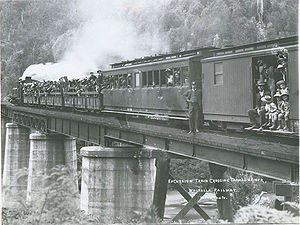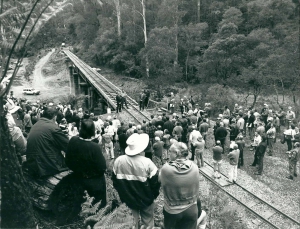Goldfields Railway
Gold was first discovered at Walhalla in 1862, and for nearly 50 years the town produced vast amounts of the precious metal in deep underground mines. Due to the town’s great isolation, transport costs for mining supplies, firewood and town provisions were extremely expensive. By the early 1870s, Walhalla started agitating for its own rail connection to the outside world but State Government approval was not granted until 1900. In order to save money on construction costs it was decided to build the line in the 2’6” (762mm) narrow gauge – identical to three other lines including the famous ‘Puffing Billy’ Railway in the Dandenong Ranges near Melbourne.
Construction of the 44km line from Moe commenced in 1904 and was finally completed in early 1910, with the last part of the railway beyond Erica requiring a large number of bridges and cuttings through the mountainous terrain of the district. On 3 May 1910, the railway was formally opened and services commenced, with an expectation that it would support Walhalla to a new age of prosperity.

Unfortunately for the railway, the Walhalla mines had gradually become uneconomic, despite significant investment by the major mining companies during the years the line was constructed.
Only a year after, the Long Tunnel Extended Mine closed in 1911 and its larger rival the Long Tunnel Mine closed in 1914. With no other local industries, the town collapsed and the vast majority of the population departed, leaving Walhalla as a significantly smaller settlement. In the following years, there was a resurgence of interest in Walhalla and its intriguing small railway, and special trains packed with visitors operated until 1941.
Although other towns such as Erica were supplying large volumes of sawn timber and agricultural produce, the twice weekly trains to Walhalla were operating almost empty, and the line beyond Platina (a small station servicing the still operating copper mine at Coopers Creek) was closed in April 1944. With improved road links, the final section of line between Moe and Erica closed in 1954 and the entire railway, buildings and most bridges had been removed by 1960.
During the next twenty years, two attempts were made to restore the line as a tourist railway, but neither was able to proceed. By 1991, the former railway had been completely eclipsed by trees, undergrowth and landslides – only the ruinous remains of the bridges were still in place. In that year, the Walhalla Railway Taskforce was formed with the ambitious aim of planning and entirely reconstructing the line from Erica to Walhalla. This became what we now know as the Walhalla Goldfields Railway Inc, which began the daunting task of clearing half a century of neglect in January 1993.
Fortunately, the former State Electricity Commission in nearby Yallourn had a narrow gauge railway used for brown coal transfer, and generously donated the Fowler diesel locomotive, surplus coal wagons and numerous track and equipment. The first short section of track was laid in February 1994 and the railway commenced operations in April on a very short section of line in the Thomson station yard.
Video of Walhalla in the 1960’s
Following a full reconstruction of the national heritage-listed Thomson River bridge, the first train over the bridge in 50 years followed in October 1994 and the track was built in sections (including construction of six bridges in the last kilometre) into the Walhalla Station yard for the opening of this section of the line on 15 March 2002. The Walhalla Goldfields Railway now boasts a fully operational line of 4kms, thanks to the tireless efforts of volunteers determined to see it reopened, and has been operating ever since as one of Australia’s most spectacular railway and tourism journeys.
Stay in touch to follow our progress and make Walhalla your next tourism destination.

Subscribe to Walhalla Goldfields Railway to stay up to date with all the news on the tracks.
